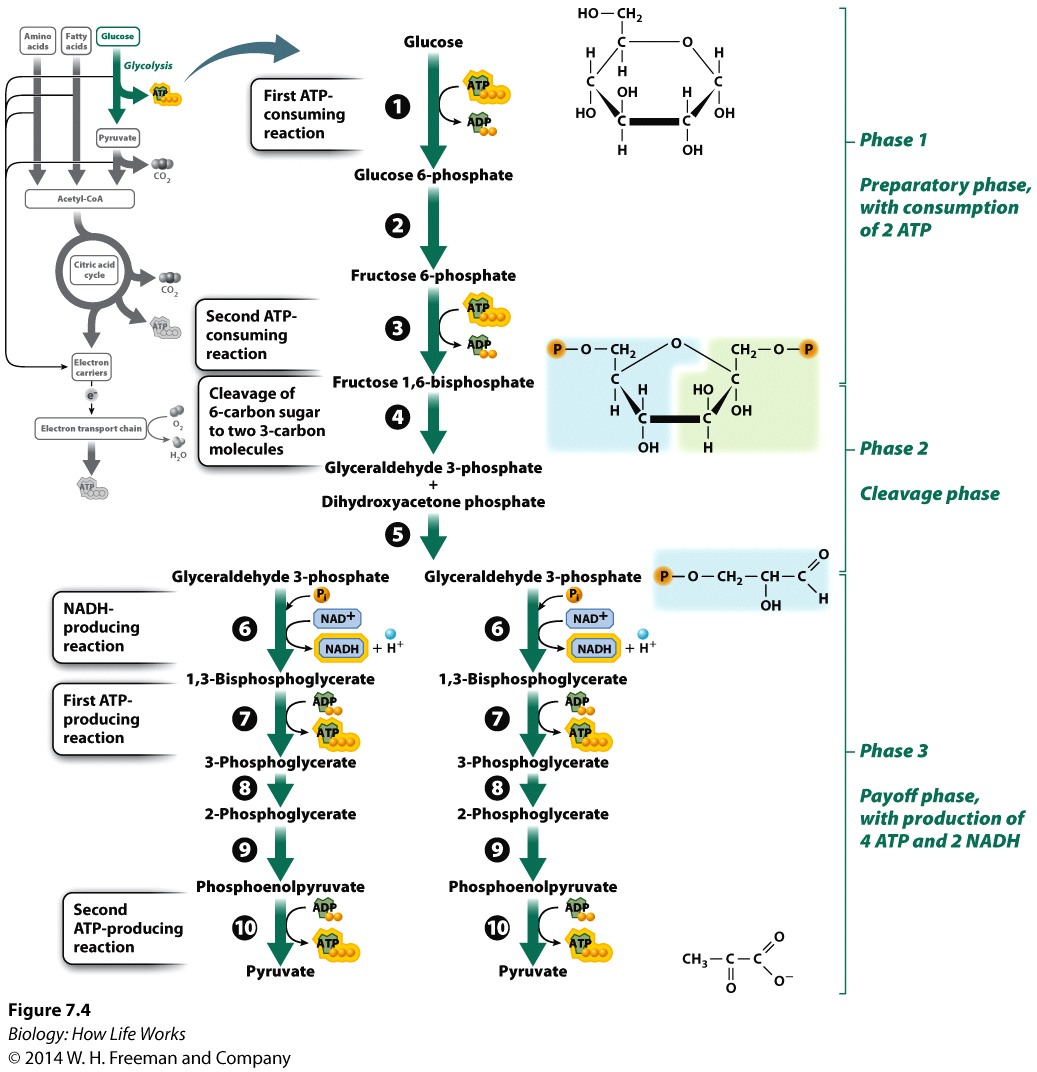7.2 GLYCOLYSIS: THE SPLITTING OF SUGAR
Glucose is the most common fuel molecule in animals, plants, and microbes. It is the starting molecule for glycolysis, which results in the partial oxidation of glucose and the synthesis of a relatively small amount of ATP and electron carriers. Glycolysis literally means “splitting sugar,” an apt name because in glycolysis a 6-carbon sugar (glucose) is split in two, yielding two 3-carbon molecules. The process is anaerobic because oxygen is not consumed. Glycolysis evolved very early in the evolution of life, when oxygen was not present in Earth’s atmosphere. It occurs in nearly all living organisms and is therefore probably the most widespread metabolic pathway among organisms.
7-6
7-7
7.2.1 Glycolysis is the partial breakdown of glucose.
Glycolysis begins with a molecule of glucose and produces two 3-carbon molecules of pyruvate and a net total of two molecules of ATP and two molecules of the electron carrier NADH. ATP is produced directly by the addition of a phosphate group to ADP, or substrate-level phosphorylation.

Glycolysis is a series of 10 chemical reactions (Fig. 7.4). These reactions can be divided into three phases. The first phase (reactions 1–3) prepares glucose for the next two phases by the addition of two phosphate groups to glucose, producing fructose 1,6-bisphosphate. This phase requires an input of energy. To supply that energy and the phosphate groups, two molecules of ATP are hydrolyzed per molecule of glucose. In other words, the first phase of glycolysis is an endergonic process. The phosphorylation of glucose has two important consequences. While glucose enters and exits cells through specific membrane transporters, phosphorylated glucose is trapped inside the cell. In addition, the presence of two negatively charged phosphate groups in proximity destabilizes the molecule so that it can be broken apart in the second phase of glycolysis.
The second phase (reactions 4 and 5) is the cleavage phase. In reaction 4, the 6-carbon molecule fructose 1,6-bisphosphate is split into two 3-carbon molecules, glyceraldehyde 3-phosphate and its isomer dihydroxyacetone phosphate. Then, in reaction 5, dihydroxyacetone phosphate is converted to glyceraldehyde 3-phosphate. For each molecule of glucose entering glycolysis, two 3-carbon glyceraldehyde 3-phosphate molecules enter the third phase.
Reactions 6–10 are the third and final phase of glycolysis. This phase ends with the production of two molecules of pyruvate. It is sometimes called the payoff phase because ATP and the electron carrier NADH are produced. Later, NADH will contribute to the synthesis of ATP during oxidative phosphorylation.
In summary, glycolysis begins with a single molecule of glucose (six carbons) and produces two molecules of pyruvate (three carbons each). These reactions yield four molecules of ATP and two molecules of NADH. However, two ATP molecules are consumed during the initial phase of glycolysis, resulting in a net gain of two ATP molecules and two molecules of NADH (Fig. 7.4; Table 7.1). The overall chemical equation for glycolysis is as follows:
Glucose + 2 NAD+ + 2 ADP + 2 Pi → 2 pyruvate + 2 ATP + 2 NADH + 2H+ + 2H2O
| Table 7.1: Approximate Total ATP Yield in Cellular Respiration | |||
|---|---|---|---|
| PATHWAY | SUBSTRATE-LEVEL PHOSPHORYLATION | OXIDATIVE PHOSPHORYLATION | TOTAL ATP |
| Glycolysis (Glucose → 2 pyruvate) |
2 ATP | 2 NADH = 5 ATP | 7 |
| Acetyl-CoA Synthesis (2 Pyruvate → 2 acetyl-CoA) |
0 ATP | 2 NADH = 5 ATP | 5 |
| Citric acid cycle (2 turns, 1 for each acetyl-CoA) | 2 ATP | 6 NADH = 15 ATP 2 FADH2 = 3 ATP |
20 |
| Total | 4 ATP | 28 ATP | 32 |